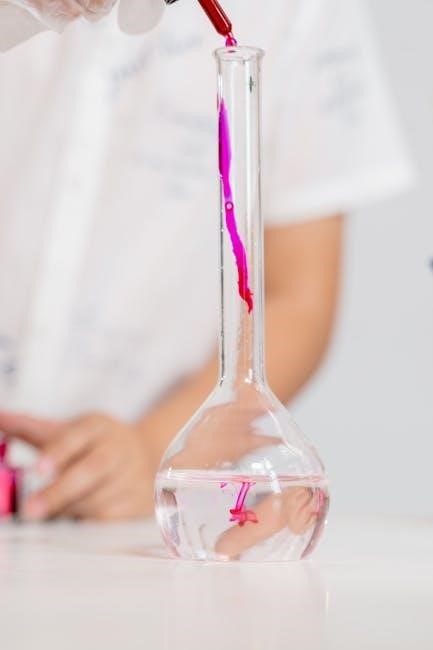The QuickVue Strep A Test is a rapid diagnostic tool for detecting Group A Streptococcus antigens in throat swabs‚ providing accurate results in minutes for timely clinical decisions․
Overview of the QuickVue Strep A Test
The QuickVue Strep A Test is a rapid‚ in-line diagnostic tool designed to detect Group A Streptococcal antigens directly from throat swab specimens․ Utilizing advanced immunochromatographic technology‚ it provides accurate and reliable results within minutes‚ aiding in the timely diagnosis of streptococcal pharyngitis․ The test is user-friendly‚ requiring minimal training‚ and is suitable for clinical and point-of-care settings․ Its unique extraction process ensures efficient antigen detection‚ making it a valuable tool for healthcare professionals to quickly confirm infections and guide appropriate treatment․ This rapid testing solution supports improved patient care and reduces the need for follow-up visits․
Importance of Rapid Strep Testing
Rapid strep testing‚ such as the QuickVue Strep A Test‚ is crucial for promptly identifying Group A Streptococcal infections‚ enabling timely antibiotic treatment and reducing complications․ Early detection prevents the spread of infection and avoids unnecessary antibiotic use․ The quick results minimize patient anxiety and allow for immediate clinical decisions‚ improving patient outcomes and streamlining healthcare workflows․ This method ensures accurate and reliable results‚ making it essential for effective disease management and preventing potential complications like rheumatic fever․ Rapid testing’s efficiency supports better public health outcomes by curbing the spread of infectious diseases and optimizing resource allocation in healthcare settings․ Its impact is significant in both clinical and community health contexts․
Intended Use of the QuickVue Strep A Test
The QuickVue Strep A Test is designed for the rapid detection of Group A Streptococcal antigens in throat swab specimens․ It is intended to aid in the diagnosis of streptococcal pharyngitis in clinical settings․ The test is suitable for use in healthcare facilities‚ clinics‚ or physician offices‚ providing quick and reliable results to guide appropriate treatment decisions․ It is not intended for self-testing or use outside of a professional healthcare environment․ The test is designed to be easy to use‚ with minimal training required‚ and provides results in minutes‚ making it an essential tool for timely patient care and infection control․
Components of the QuickVue Strep A Test Kit
The QuickVue Strep A Test Kit includes a test cassette‚ extraction solution‚ sterile swabs‚ and a detailed package insert for accurate and reliable testing procedures․
Test Cassette
The test cassette is a single-use‚ portable device containing a unique in-line extraction system․ It detects Group A Streptococcus antigens directly from throat swabs․ The cassette is designed for simplicity‚ with clear test lines indicating results․ It ensures accurate detection with minimal training required․ Proper handling and storage‚ as per the package insert‚ are essential for maintaining its effectiveness․ The cassette is a critical component‚ providing quick and reliable results to aid in timely clinical decisions for strep throat diagnosis and treatment․
Extraction Solution
The extraction solution is a critical component of the QuickVue Strep A Test‚ designed to release Group A Streptococcus antigens from throat swabs․ It ensures accurate test results by breaking down the sample‚ making antigens detectable․ The solution must be used as directed in the package insert to avoid invalid results․ Proper handling and storage are essential to maintain its efficacy․ The extraction solution simplifies the testing process‚ enabling rapid and reliable detection of strep throat infections‚ which is vital for timely patient care and treatment decisions․
Swabs
The QuickVue Strep A Test includes sterile swabs designed for collecting throat specimens from the tonsils and posterior pharynx․ Proper swab technique is essential to ensure accurate results․ The swabs are pre-treated to maintain sample integrity and must be used as directed in the package insert․ Avoid contaminating the swabs with external materials․ After collecting the specimen‚ proceed immediately to the extraction step to prevent sample degradation․ The swabs are a critical component for obtaining reliable test outcomes‚ enabling healthcare providers to diagnose strep throat effectively and initiate appropriate treatment plans without delay․
Package Insert
The package insert provides comprehensive instructions for the QuickVue Strep A Test‚ including storage conditions‚ safety protocols‚ and step-by-step testing procedures․ It contains critical information such as the test’s intended use‚ components‚ and interpretation of results․ The insert also outlines universal precautions‚ handling of biological samples‚ and proper disposal of materials․ Adherence to the instructions in the package insert is essential for ensuring accurate and reliable test outcomes․ Additionally‚ the insert includes troubleshooting guidelines and information on test limitations․ Always read and follow the package insert carefully before performing the test to maintain compliance with safety and testing standards․
Preparation for the QuickVue Strep A Test
Preparation involves gathering materials‚ reading the package insert‚ and preparing the testing area to ensure accurate results and adherence to safety protocols․
Gathering Materials
To begin‚ ensure all necessary components of the QuickVue Strep A Test kit are available․ This includes the test cassette‚ extraction solution‚ sterile swabs‚ and the package insert․ Each swab should be individually wrapped to maintain sterility․ Verify that all materials are within their expiration dates and appear undamaged․ Additionally‚ have a clean‚ flat surface prepared for the testing area․ It is crucial to review the package insert instructions beforehand to familiarize yourself with the procedure․ Ensure all materials are easily accessible to streamline the testing process and minimize delays․ Proper preparation ensures accurate and reliable test results․
Reading the Package Insert
Reading the package insert is a critical step before performing the QuickVue Strep A Test․ It contains essential information‚ including test components‚ instructions‚ and safety precautions․ The insert details the step-by-step procedure‚ ensuring accurate results․ It also outlines universal precautions‚ such as handling biological samples safely and proper disposal methods․ Additionally‚ the package insert provides troubleshooting guidance for common issues and clinical considerations for test interpretation․ Familiarizing yourself with the insert ensures compliance with regulatory standards and helps avoid errors․ Always follow the instructions carefully to guarantee reliable outcomes and maintain patient safety throughout the testing process․
Preparing the Testing Area
Preparing the testing area ensures a clean and organized environment for the QuickVue Strep A Test․ Begin by cleaning the workspace with a disinfectant and gathering all necessary materials within easy reach․ Place the test cassette‚ extraction solution‚ and swabs on a flat‚ stable surface․ Wear gloves to handle potentially biohazardous samples․ Ensure proper lighting and maintain a clutter-free area to prevent contamination or accidental damage to components․ Additionally‚ have a biohazard waste container nearby for safe disposal of used materials․ Proper preparation minimizes errors and ensures smooth execution of the testing procedure․ Always follow universal precautions to maintain safety and accuracy throughout the process․

Step-by-Step Testing Procedure
The QuickVue Strep A Test involves collecting a throat swab‚ performing extraction‚ adding the sample to the test cassette‚ and waiting for results‚ ensuring accurate and rapid detection of Group A Streptococcus․
Step 1: Collecting the Throat Swab
Collecting the throat swab is the first step in the QuickVue Strep A Test․ Gently swab the tonsils and the back of the throat using the provided sterile swab․ Avoid touching the tongue‚ cheeks‚ or gums to prevent contamination․ Hold the swab by the handle‚ ensuring the tip does not come into contact with any surfaces․ Swiftly rub the swab over both tonsils and the posterior pharynx to collect an adequate sample․ After collecting the specimen‚ carefully place the swab into the provided extraction solution‚ making sure not to spill or splatter․ Handle the swab safely to maintain sterility and accuracy in the test results․
Step 2: Performing the Extraction
After collecting the throat swab‚ insert it into the extraction solution vial․ Rotate the swab gently for about 10 seconds to release the specimen into the solution․ Ensure the swab is fully saturated․ Using the swab‚ scrape the inside of the vial to release any remaining material․ Discard the swab responsibly․ Hold the vial vertically and allow one free-falling drop of the extracted sample to fall onto the test cassette’s sample well․ Avoid touching the dropper to the cassette to prevent contamination․ This step ensures the sample is properly prepared for antigen detection in the subsequent testing phase․
Step 3: Adding the Sample to the Test Cassette
Using the dropper provided‚ carefully place one free-falling drop of the extracted sample onto the sample well of the test cassette․ Ensure the drop is centered and avoid touching the dropper tip to the cassette to prevent contamination․ The sample well is typically located on one end of the cassette‚ marked for easy identification․ Once the sample is added‚ use the dropper tip to gently wipe away any excess sample from the edge of the well․ This step ensures proper antigen migration and accurate test results․ Always follow the instructions in the package insert for correct sample application․
Step 4: Waiting for Results
After adding the sample to the test cassette‚ place it on a flat surface and wait 5 minutes for the results to develop․ During this time‚ avoid touching or handling the cassette excessively‚ as this could interfere with the test’s accuracy․ The test will display results even if lines appear before the 5-minute mark‚ but it is crucial to wait the full duration for accurate interpretation․ Once the 5 minutes have elapsed‚ read the results by observing the presence or absence of control and test lines․ Ensure the cassette remains untouched during the waiting period to prevent contamination or errors in reading․

Interpreting the Test Results
The test results are read by observing the presence or absence of control and test lines․ A visible control line ensures the test is valid․ A test line indicates a positive result‚ while its absence means the result is negative․ Faint lines still count as positive․ Always follow the package insert for accurate interpretation․
Understanding Positive Results
A positive result is indicated by the appearance of a test line‚ confirming the presence of Group A Streptococcus antigens․ This means the patient likely has strep throat․ Even faint lines are positive․ Positive results should prompt appropriate antibiotic treatment to prevent complications․ Always interpret results within the specified timeframe and according to the package insert instructions․ A positive test is highly accurate but may require culture confirmation in some cases․ Ensure proper documentation and follow clinical guidelines for patient management․ Positive results enable timely intervention‚ reducing the risk of spreading the infection and improving patient outcomes․
Understanding Negative Results
A negative result is indicated by the absence of a test line‚ while the control line appears‚ confirming the test worked properly․ This suggests the absence of Group A Streptococcus antigens․ However‚ a negative result does not entirely rule out strep throat‚ especially if symptoms are present․ False negatives can occur due to improper sample collection or early infection stages․ In such cases‚ a throat culture may be recommended for confirmation․ It is crucial to follow the package insert instructions for interpreting results accurately․ Consult a healthcare professional for further evaluation and appropriate management if symptoms persist despite a negative result․
Handling Inconclusive Results
If the test result is inconclusive‚ such as faint or unclear lines‚ it may indicate improper test execution or insufficient sample․ Repeat the test with a new kit‚ ensuring all steps are followed precisely․ Use a fresh swab and carefully adhere to the package insert instructions․ If uncertainty persists‚ consult a healthcare provider for further evaluation or confirmatory testing․ Proper disposal of used materials is essential to maintain safety and prevent contamination․ Always follow universal precautions when handling biological samples to ensure accurate results and patient safety․ Inconclusive results should not be relied upon for clinical decisions without additional testing or professional guidance․

Safety Precautions and Universal Protocols
Handle biological samples safely‚ wearing gloves and protective equipment․ Dispose of materials properly to prevent contamination․ Follow universal precautions and package insert guidelines to ensure accuracy and safety․
Universal Precautions
Always wear gloves and protective equipment when handling biological samples to minimize exposure risks․ Ensure proper handwashing before and after the procedure․ Maintain a clean workspace to prevent cross-contamination․ Follow biosafety guidelines when handling throat swabs and extraction solutions․ Dispose of all materials‚ including swabs and test cassettes‚ in biohazard waste containers․ Adhere to laboratory safety protocols and manufacturer instructions for handling potentially infectious specimens․ Properly decontaminate surfaces after testing․ Universal precautions are essential to protect healthcare workers and maintain test accuracy․ Refer to the package insert for specific safety recommendations․
Safe Handling of Biological Samples
Handle throat swabs and test materials with care to avoid contamination․ Use sterile swabs for sample collection to ensure accurate results․ Avoid touching the swab tip to prevent introducing bacteria․ When performing the extraction‚ keep the solution away from skin and eyes․ Store biological samples in sealed containers if not tested immediately․ Dispose of swabs and samples in biohazard waste after testing․ Ensure all materials are handled in a well-ventilated area․ Follow CDC guidelines for handling infectious agents․ Properly label and store samples to maintain integrity․ Adhere to laboratory safety protocols to minimize exposure risks․ Always refer to the package insert for specific handling instructions․
Proper Disposal of Test Materials
Dispose of all test materials‚ including used swabs‚ extraction solutions‚ and test cassettes‚ as biohazardous waste․ Place items in sealed biohazard bags or approved containers․ Ensure proper labeling of waste containers according to local regulations․ Do not reuse or recycle test components․ Chemical waste‚ such as extraction solutions‚ should be handled separately and disposed of per hazardous waste guidelines․ Clean any spills with appropriate disinfectants before disposal․ Follow institutional protocols for waste management to minimize environmental and health risks․ Always refer to the package insert for specific disposal instructions for the QuickVue Strep A Test materials․
Troubleshooting Common Issues
Common issues include invalid results‚ procedural errors‚ or damaged test kits․ Refer to the package insert for resolution steps or contact technical support for assistance․
Invalid Test Results
Invalid test results may occur due to improper procedure or expired reagents․ Check the test cassette for damage or contamination․ Ensure all steps are followed as per the package insert․ If issues persist‚ contact the manufacturer or consult the troubleshooting guide․ Always verify the expiration dates of components and store them correctly to maintain efficacy․ Proper training and adherence to protocols can minimize invalid outcomes‚ ensuring reliable and accurate test results․
Common User Errors
Common user errors include improper swabbing technique‚ failure to follow package insert instructions‚ and incorrect handling of the extraction solution․ Not waiting the full 5 minutes for results or mishandling the test cassette can lead to false negatives or positives․ Additionally‚ ignoring the control line or not performing the test on the correct type of swab specimen can affect accuracy․ Proper training and adherence to the step-by-step procedure are essential to minimize errors and ensure reliable test outcomes․ Always review the test protocol before performing the test to avoid mistakes․
Test Kit Expiry or Damage
The QuickVue Strep A Test kit may expire or become damaged due to improper storage‚ mishandling‚ or exceeding its shelf life․ Always check the expiration date on the packaging before use․ Visible signs of damage‚ such as broken or cracked components‚ render the kit unusable․ Expired or damaged kits can lead to inaccurate results‚ as the reagents may degrade over time․ If a kit is past its expiration date or shows signs of damage‚ it should be discarded immediately․ Use only intact‚ unexpired kits to ensure reliable test performance․ Always refer to the package insert for storage instructions to maintain kit integrity and effectiveness․

Clinical Considerations
The QuickVue Strep A Test aids in diagnosing streptococcal pharyngitis‚ guiding timely antibiotic treatment and reducing complications․ Its rapid results support effective patient management and infection control strategies․
When to Use the QuickVue Strep A Test
The QuickVue Strep A Test is used to detect Group A Streptococcal antigen in throat swabs‚ aiding in the diagnosis of streptococcal pharyngitis․ It is recommended for patients presenting with symptoms such as sore throat‚ fever‚ or swollen lymph nodes․ The test is particularly useful in clinical settings where rapid results are needed to guide treatment decisions․ It is intended for use in individuals suspected of having strep throat based on clinical evaluation․ The QuickVue Strep A Test should be used when timely and accurate diagnosis is critical to prevent complications and reduce the spread of infection․
Limitations of Rapid Testing
While the QuickVue Strep A Test offers rapid results‚ it has limitations․ False negatives may occur if the sample collection is inadequate or if the infection is in its early stages․ The test’s accuracy depends on proper specimen handling and adherence to instructions․ It may not detect Group A Streptococcus in asymptomatic carriers or cases with low bacterial loads․ Additionally‚ rapid antigen tests like QuickVue are not a substitute for throat culture‚ which remains the gold standard for diagnosis․ Negative results should be confirmed with culture‚ especially in high-risk patients or when clinical suspicion remains high despite a negative rapid test․
Follow-Up Actions Based on Results
Positive results for Group A Streptococcus indicate bacterial pharyngitis‚ warranting immediate antibiotic treatment to prevent complications like rheumatic fever․ Negative results should be confirmed with a throat culture‚ especially in high-risk patients or when symptoms persist․ If clinical suspicion remains‚ further testing is recommended․ Proper disposal of test materials and adherence to infection control protocols are essential․ Ensure patient education on hygiene and medication adherence․ Follow-up appointments may be necessary to confirm resolution or adjust treatment plans based on culture results or clinical progression․